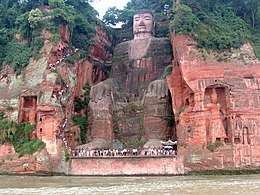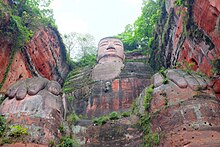The Leshan Giant Buddha (Chinese: 樂山大佛) is a 71-metre (233 ft) tall stone statue, built between 713 and 803 (during the Tang dynasty). It is carved out of a cliff face of Cretaceous red bed sandstones that lies at the confluence of the Min River and Dadu River in the southern part of Sichuan province in China, near the city of Leshan. The stone sculpture faces Mount Emei, with the rivers flowing below its feet. It is the largest and tallest stone Buddha statue in the world and it is by far the tallest pre-modern statue in the world. It is over 4 km from the Wuyou Temple.
The Mount Emei Scenic Area, including Leshan Giant Buddha Scenic Area, has been listed as a UNESCO World Heritage Site since 1996.
Location
The Leshan Giant Buddha is located at the Lingyun Mountain’s Qifeng Peak. Qifeng Peak is located at the junction of the Minjiang River, Qingyi River, and Dadu River.
Other than the Leshan Giant Buddha, the Danxia Landform also contains abundant history and cultural connotations, such as cliff tombs and cliff dwelling. The Mahao Cliff Tombs at the Leshan Giant Buddha scenic area were built in the Han Dynasty, indicating ancient local residents’ living habits
History
Construction started in 723 AD, led by a Chinese Buddhist monk named Hai Tong. He believed that Maitreya Buddha would calm the turbulent waters that constantly plagued the shipping vessels traveling down the river. When funding for the project was threatened, he is said to have gouged out his own eyes to show his piety and sincerity. After his death, however, the construction was delayed due to insufficient funding. The statue was only completed from the shoulders up at the time. Several years later, Hai Tong’s disciples continued work on the statue with financial support from a local official named Zhangchou Jianxiong. Hai Tong’s disciples continued the construction until the Knees, when construction was halted because Zhangchou JianXiang was called back to serve at the royal court in Chang’an. About 70 years later, Jiedushi Wei Gao continued to support and funded the project and the construction was finally completed by Hai Tong’s disciples in 803.
By the beginning of the Northern Song Dynasty, the Leshan Giant Buddha had been damaged—the body was covered in moss, and the wooden pavilion had collapsed. During the reign of Song Renzong, the Giant Buddha was repaired once on a large scale and the wooden pavilion was rebuilt. Since then, the records of the destruction and reconstruction of the Buddha have been missing, and the original temple, Lingyun Temple, had been destroyed by war many times.
Apparently, the massive construction resulted in so much stone being removed from the cliff face and deposited into the river below that the currents were indeed altered by the statue, making the water safe for passing ships.
A sophisticated drainage system was incorporated into the Leshan Giant Buddha when it was built. It is still in working order. It includes drainage pipes carved into various places on the body, to carry away the water after the rains so as to reduce weathering.
When the Giant Buddha was carved, a huge thirteen story wood structure (similar to the one at the Rongxian Giant Buddha) was built to shelter it from rain and sunshine. This structure was destroyed and sacked by the Mongols during the wars at the end of the Yuan dynasty. From then on, the stone statue was exposed to the elements.
Gallery
https://www.tiktok.com/@aprilooi/video/6937975849098562822







